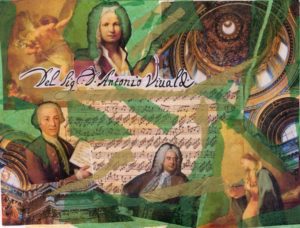Saturday, December 9, 2023 at 8:00 pm
Pre-concert talk at 7:00 pm by director Freddie Coleman
Featured Works
Gloria in D Major by Antonio Vivaldi
Nisi Dominus by George Frideric Handel
Magnificat in Bb by Francesco Durante
Magnificat Primo by Chiara Margarita Cozzolani
The Seattle Choral Company kicks off their 42nd season with a holiday concert devoted to Baroque choral masterworks from Italy. Italy, long regarded as the birthplace of Baroque music, led the way during the 17th century with a style of music that was known for its grandiose, dramatic, and energetic spirit.
Four Italian cities will be represented, beginning with Milan, where Chiara Margarita Cozzolani published and performed works for the convent at Santa Radegonda, drawing attention from the outside world. Then, on to Naples, where Francesco Durante (1684-1755) premiered his Magnificat in B Flat Major. In Rome, a young George Frideric Handel (1685-1759) composed his brilliant cantata, Nisi Dominus. Finally, in Venice, Antonio Vivaldi (1678-1741) produced an astonishing range and quantity of music, including his choral masterpiece, Gloria in D Major.
The SCC will be joined by a talented quintet of Northwest regional soloists: Jocelyn Claire Thomas and Jennifer Bromagen, sopranos; Sarah Mattox, mezzo-soprano; Zach Finkelstein, tenor; and Zachary Lenox, baritone. Members of the North Corner Chamber Orchestra will also take part in this festive holiday evening.
Guest Artists

Jocelyn Claire Thomas, soprano

Jennifer Bromagen, soprano

Sarah Mattox. mezzo-soprano

Zach Finkelstein, tenor

Zachary Lenox, baritone

Members of the North Corner Chamber Orchestra
About the Music
I. Gloria (SATB Chorus)
II. Et in terra pax (SATB Chorus)
III. Laudamus te (Duet for Two Sopranos)
IV. Gratias agimus tibi (SATB Chorus)
V. Propter magnam gloriam (SATB Chorus)
VI. Domine Deus (Soprano Solo, Oboe Solo)
VII. Domine, Fili unigenite (SATB Chorus)
VIII. Domine Deus, Agnus Dei (Alto Solo with SATB Chorus)
IX. Qui tollis peccata mundi (SATB Chorus)
X. Qui sedes ad dexteram Patris (Alto Solo)
XI. Quoniam tu solus sanctus (SATB Chorus)
XII. Cum Sancto Spiritu (SATB Chorus)
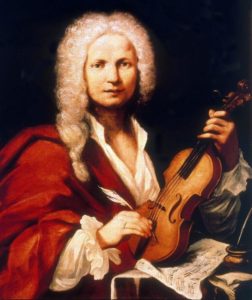
Antonio Vivaldi
Antonio Lucio Vivaldi composed this Gloria in Venice, probably in 1715, for the choir of the Ospedale della Pietà, an orphanage for girls (or more probably a home, generously endowed by the girls’ “anonymous” fathers, for the illegitimate daughters of Venetian noblemen and their mistresses). The Ospedale prided itself on the quality of its musical education and the excellence of its choir and orchestra. Vivaldi, a priest, music teacher and virtuoso violinist, composed many sacred works for the Ospedale, where he spent most of his career, as well as hundreds of instrumental concertos to be played by the girls’ orchestra. This, his most famous choral piece, presents the traditional Gloria from the Latin Mass in twelve varied cantata-like sections.
The wonderfully sunny nature of the Gloria, with its distinctive melodies and rhythms, is characteristic of all of Vivaldi’s music, giving it an immediate and universal appeal. The opening movement is a joyous chorus, with trumpet and oboe obligato. The extensive orchestral introduction establishes two simple motives, one of octave leaps, the other a quicker, quaver – semiquaver figure, that function as the ritornello. The choir enters in chorale-like fashion, syllabically declaiming the text in regular rhythms, contrasting with the orchestral ritornello, which contains most of the melodic interest of the movement.
The B minor Et in terra pax is in nearly every way a contrast to the first. It is in triple rather than duple time, in a minor key, and rather slower. Its imitative and expressive chromatic texture evokes the motets of the Renaissance era, the so-called “stile antico”. Laudamus te, a passionate duet for two sopranos, gives us some hint of the skill of Vivaldi’s young singers.
Gratias agimus tibi is a very broad and entirely homophonic prelude to a fugal allegro on propter magnam gloriam. The Largo Domine Deus, Rex coelestis is in the form of duet between the solo soprano and the solo violin, followed by the joyful F major Domine Fili unigenite chorus in what Vivaldi and his contemporaries would have regarded as the ‘French style’. It is dominated by the dotted rhythms characteristic of a French overture. Domine Deus, Agnus Dei features the alto soloist, with the chorus providing an antiphonal response, “qui tollis peccata mundi”, to each intercession. The bold harmonies of the following section, Qui tollis, provide a refreshing change of tone color, and complement the intercessional alto aria, Qui sedes ad dextera Patris. The string accompaniment contains recollections of the opening movement, and prepares for the following movement, Quoniam tu solus sanctus, which takes the shape of a brief reprise of the opening movement’s broken octaves.
The powerful “stile antico” double fugue on Cum Sancto Spiritu that ends the work is an arrangement by Vivaldi of the ending of a Gloria for two choirs composed in 1708 by an older contemporary, the now forgotten Veronese composer Giovanni Maria Ruggieri, whom Vivaldi seems to have held in high esteem.
Today Vivaldi is one of the most popular of all composers, who during his lifetime enjoyed considerable success and fortune, which he squandered through extravagance, and when he died in Vienna he was buried in a pauper’s grave. For two centuries after his death, the Gloria lay undiscovered until the late 1920s, when it was found buried among a pile of forgotten Vivaldi manuscripts. However, it was not performed until September 1939 in Siena in an edition by the composer Alfredo Casella. This was by no means an authentic edition (he described it as an “elaborazione”), as he embellished the original orchestration of trumpet, oboe, strings, and continuo, while reducing the role of the continuo, and cut sections from three movements. It was not until 1957 that the now familiar original version was published and given its first performance at the First Festival of Baroque Choral Music at Brooklyn College, NY.
Peter Carey
Royal Free Singers
I. Nisi Dominus (SSATB Soli, SSATB Chorus)
II. Vanum est vobis (Tenor Solo)
III. Cum dederit dilectis (Alto Solo)
IV. Sicut sagittae (Bass Solo)
V. Beatus vir (Tenor Solo)
VI. Gloria Patri (SSATB Soli, SATB Chorus)
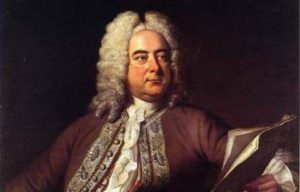
George Frideric Handel
George Frideric Handel (23 February 1685 – 14 April 1759) was a German, later British, Baroque composer, who spent the bulk of his career in London, becoming well known for his operas, oratorios, anthems, and organ concertos. Handel received musical training in Halle and worked as a composer in Hamburg and Italy before settling in London in 1712; he became a naturalized British subject in 1727. He was strongly influenced both by the great composers of the Italian Baroque and by the middle-German polyphonic choral tradition. In 1706 Handel travelled to Italy at the invitation of Ferdinando de’ Medici. De’ Medici, who had a keen interest in opera, was trying to make Florence Italy’s musical capital by attracting the leading talents of his day. Handel subsequently traveled to Rome and, since opera was banned (temporarily) in the Papal States, composed sacred music for the Roman clergy.
Italy was the center of European music. One of the most notable traits of Italian music was the expressive style in which its composers wrote for the voice. Italian vocal writing was characterized by qualities of suppleness, expansiveness, flexibility, and lyricism. Handel would quickly master the art, and Italian opera would become the bedrock of his career. But in Rome, where he spent most of his time between 1706 and 1710, papal decrees had closed the public theaters since 1698; the ban was not lifted until 1709. Nevertheless, the musical styles of opera, barely disguised, were manifested in concert performances and in particular through the Italian cantata (motet).
Nisi Dominus is a setting of the Latin text of Psalm 127. It was completed by 13 July 1707. It is scored for five vocal soloists, chorus, strings (including solo violin in one aria), with basso continuo. The bass solo (“Sicut sagittae”) is especially notable for its tone-painting: “flying” strings evoke the flight of arrows. Handel returned to the opening section of his Nisi Dominus and the theme of the concluding fugue in his famous Coronation Anthems, Zadok the Priest and The King Shall Rejoice. This shows that in his maturity he still had a great deal of respect for the compositional models he developed in his early Latin church music.
I. Magnificat (SATB Chorus)
II. Et misericordia (Soprano/Alto Duet & SATB chorus)
III. Deposuit potentes (SATB Chorus)
IV. Suscepit Israel (Tenor/Baritone Duet)
V. Sicut locutus est (SATB Chorus)
VI. Gloria Patri (SATB Chorus)
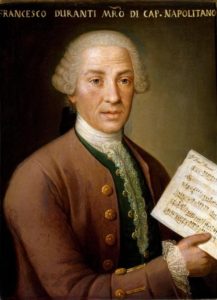
Francesco Durante
In the perception of many music lovers, Francesco Durante may be a relatively minor name among Italian baroque composers. But in his own time, Durante’s fame was unquestioned. Even at the end of the 19th century he was still described in musical literature as “one of the greatest Italian church composers and composition teachers of all time.”
He was the leading composer of the late baroque Neapolitan school, and music teacher (Primo Maestro) at the Poveri di Gesù Cristo, Santa Maria di Loreto and Sant’Onofrio conservatories at Naples, having an impressive list of students who later became well-known composers themselves (among them Niccolò Jommelli, Giovanni Paisiello, Giovanni Battista Pergolesi, Niccolò Piccinni, Leonardo Vinci). He was firmly rooted in the Neapolitan music scene, but in spite of his very local roots, manuscripts of his works are to be found all over Italy and Europe, which must be indicative for the popularity his work enjoyed during the 18th and even the first half of the 19th century. Durante’s church music in general has been immensely popular until long after his death in 1755, and many of his works have survived by more than one source. Johann Sebastian Bach is known to have copied and arranged works by Durante.
Of the vocal compositions by Durante, the Magnificat in B flat major is undoubtedly one of his most important compositions and one of the most significant settings of this text in cantata form. It masterfully combines the traditional polyphonic notation with modern, early Classical elements.
Composed for eight-part choir and basso continuo
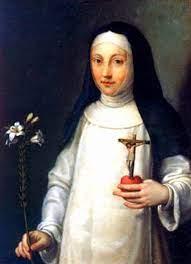
Chiara Margarita Cozzolani
Chiara Margarita Cozzolani, born the youngest child of a wealthy merchant family, followed in the footsteps of many of her relatives by becoming a nun. She joined the Benedictine monastery of Santa Radegonda in Milan, Italy, at age 18. Her musical education likely consisted of singing in one of two choirs that regularly performed for family and occasional dignitaries such as the Grand Duke Cosimo III de Medici in 1664. She may also have served as the choirmaster.
Cozzolani was a talented singer and composer. Her first published work, Primavera dei fiori musicali (Springtime of Musical Blossoms), dedicated to Archbishop Monti, was lost during World War II along with some of her secular cantatas. Her 1642 composition, Concerti sacri, dedicated to Mathias de’ Medici, included motets for two to four voices using new techniques in the Lombardian style including the use of refrains in solo motets and duet and quartet concerti.
Her final published volume, written in 1650, included large scale Vespers with mixed solo and duet writing plus two choir antiphons accompanied by violins and organ. The same publication featured Psalms, motets and two Magnificats dedicated to the Virgin Mary for eight voices, including parts for men, revealing the beginning of more sophisticated and inclusive spiritual and musical relationships. The SCC will perform the first of this pair of Nativity works.
Cozzolani composed less frequently for the remainder of her life when she undertook more monastery duties, serving as Prioress in 1664 and 1671 and Abbess from 1658 to 1660 and again in 1672. Because her published music circulated in Germany and France, she was able to establish her legacy as a composer of note beyond her years in the convent.

